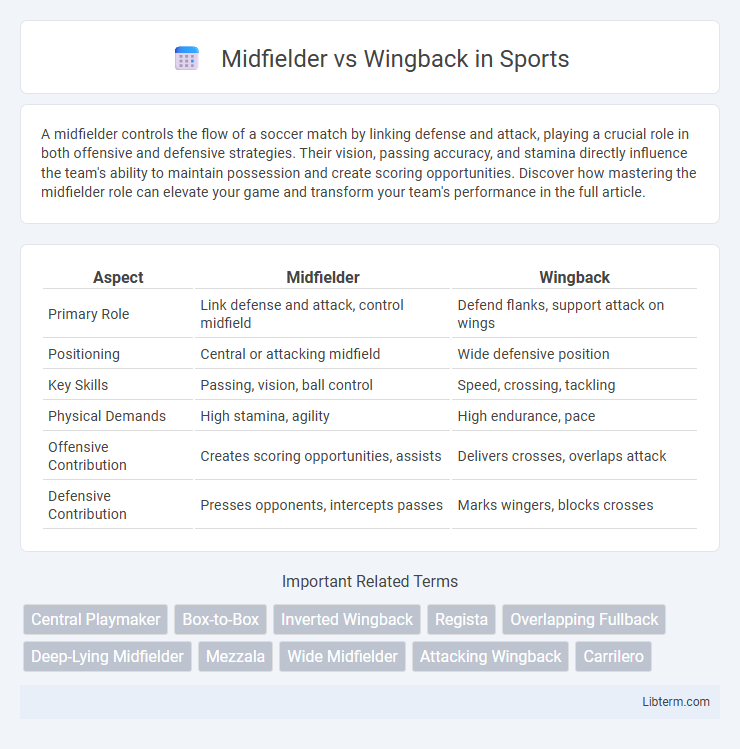A midfielder controls the flow of a soccer match by linking defense and attack, playing a crucial role in both offensive and defensive strategies. Their vision, passing accuracy, and stamina directly influence the team's ability to maintain possession and create scoring opportunities. Discover how mastering the midfielder role can elevate your game and transform your team's performance in the full article.
Table of Comparison
| Aspect | Midfielder | Wingback |
|---|---|---|
| Primary Role | Link defense and attack, control midfield | Defend flanks, support attack on wings |
| Positioning | Central or attacking midfield | Wide defensive position |
| Key Skills | Passing, vision, ball control | Speed, crossing, tackling |
| Physical Demands | High stamina, agility | High endurance, pace |
| Offensive Contribution | Creates scoring opportunities, assists | Delivers crosses, overlaps attack |
| Defensive Contribution | Presses opponents, intercepts passes | Marks wingers, blocks crosses |
Introduction to Midfielders and Wingbacks
Midfielders control the tempo of the game by linking defense and attack, often excelling in passing, vision, and ball distribution to maintain possession and create scoring opportunities. Wingbacks combine the roles of traditional full-backs and wingers, providing width in attack while fulfilling defensive duties on the flanks, requiring high stamina and pace. Both positions are crucial in modern football tactics, with midfielders orchestrating play centrally and wingbacks offering overlapping runs to stretch the opponent's defense.
Key Roles and Responsibilities
Midfielders primarily control the flow of the game by distributing passes, maintaining possession, and supporting both offensive and defensive plays. Wingbacks are responsible for providing width on the flanks, combining defensive duties with attacking runs to deliver crosses into the penalty area. The midfielder's role emphasizes ball control and playmaking, while wingbacks focus on balancing defense with wide offensive support.
Positioning on the Field
Midfielders primarily occupy central areas of the pitch, orchestrating play by linking defense and attack through precise passing and spatial awareness. Wingbacks operate along the flanks, combining defensive duties with offensive support, often pushing high up the field to deliver crosses and stretch opposing defenses. Both positions require distinct positioning strategies: midfielders control central zones to maintain possession and dictate tempo, while wingbacks exploit wide areas to create width and disrupt opponent formations.
Physical and Technical Requirements
Midfielders require exceptional stamina, agility, and ball control to maintain possession and link defense with attack, showcasing precise passing and vision. Wingbacks need high endurance and speed to consistently cover the flanks, combining defensive tackling with accurate crossing and dribbling skills. Both roles demand tactical awareness but emphasize different physical attributes and technical abilities tailored to central and wide pitch zones.
Tactical Importance in Modern Football
Midfielders control the tempo and link defense with attack, making them vital for ball distribution and transitional play, especially in formations emphasizing possession and pressing. Wingbacks provide width and defensive coverage, crucial for modern systems that rely on flexible wide players to support both offensive overlaps and compact defensive structures. Their tactical importance lies in balancing spatial control, with midfielders orchestrating central play and wingbacks exploiting flanks to create numerical advantages and disrupt opposition shape.
Differences in Defensive Duties
Midfielders primarily focus on intercepting passes, marking opponents, and supporting both defense and attack by controlling the central areas of the pitch. Wingbacks have a more specialized defensive role, often tasked with tracking opposing wingers, covering wide spaces, and preventing crosses into the box. While midfielders engage in broader defensive coverage, wingbacks balance defensive responsibilities with advancing along the flanks to support offensive plays.
Differences in Attacking Contributions
Midfielders primarily control the tempo of the game by distributing passes and orchestrating attacks through central areas, often contributing with key passes and occasional goals. Wingbacks combine defensive duties with wide attacking runs, delivering crosses and creating width to stretch the opposition's defense. While midfielders focus on ball retention and playmaking, wingbacks emphasize overlaps and crossing to supply forwards from the flanks.
Famous Midfielders vs Iconic Wingbacks
Famous midfielders like Andres Iniesta, Xavi Hernandez, and Luka Modric excel in controlling tempo, distributing precise passes, and orchestrating attacks from central positions. Iconic wingbacks such as Roberto Carlos, Cafu, and Dani Alves combine defensive solidity with explosive overlapping runs, contributing significantly to both defense and offense along the flanks. The contrast in roles highlights midfielders' playmaking and spatial awareness versus wingbacks' stamina, crossing ability, and defensive versatility.
Impact on Team Formation and Strategy
Midfielders control the game's tempo and link defense with attack, shaping formations like 4-3-3 or 4-4-2 by maintaining possession and distributing passes. Wingbacks provide width and support both defense and offense, often transforming traditional back fours into dynamic back fives, enhancing flank pressure and crossing opportunities. Teams leveraging wingbacks typically emphasize aggressive wing play and high pressing, whereas midfield-focused formations prioritize ball retention and central dominance.
Choosing Between a Midfielder and Wingback
Choosing between a midfielder and a wingback depends on the team's tactical formation and style of play; midfielders excel in controlling the game's tempo and distributing passes, while wingbacks balance defensive duties with wide attacking support. Midfielders, such as central or defensive midfielders, are crucial for maintaining possession and creating scoring opportunities, whereas wingbacks require exceptional stamina and crossing ability to contribute effectively in both defense and offense along the flanks. Coaches must assess player skill sets, team needs, and match scenarios to determine the optimal role that maximizes both defensive solidity and attacking width.
Midfielder Infographic

 libterm.com
libterm.com